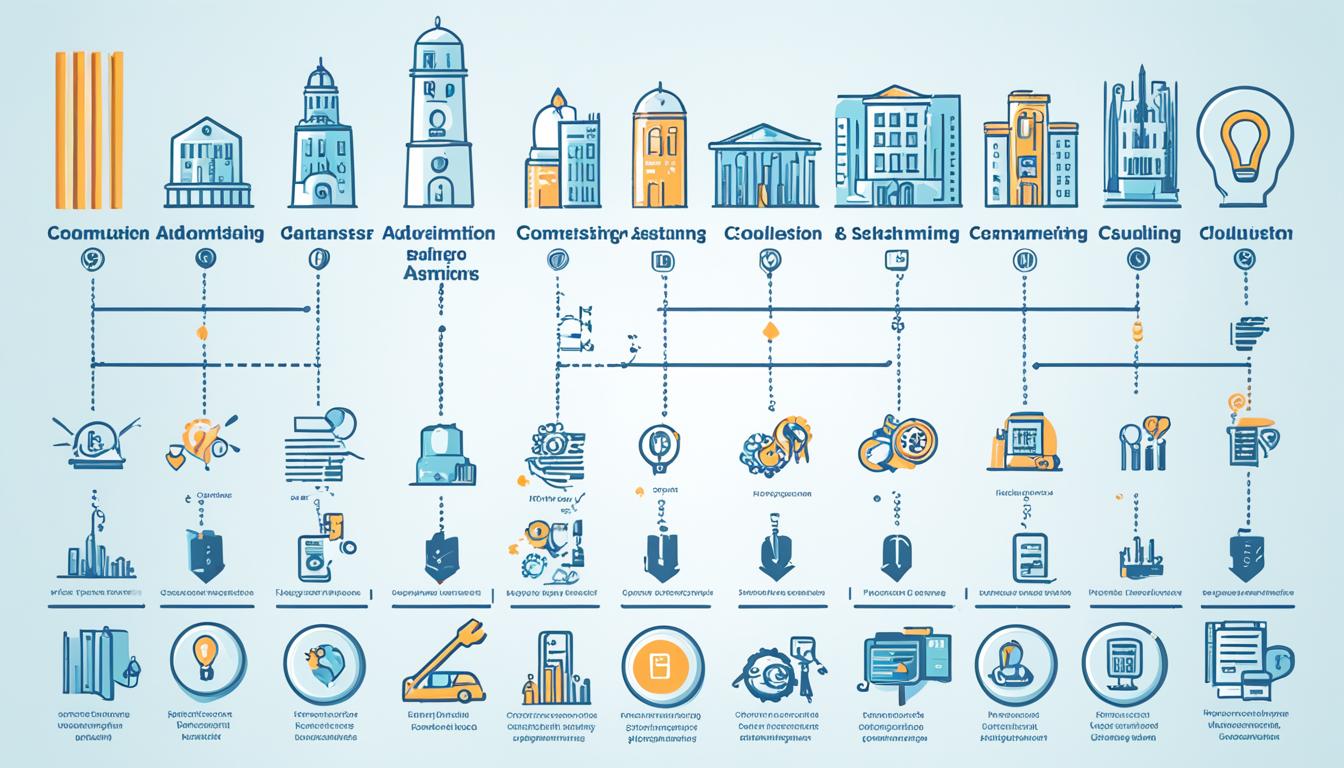In this comprehensive guide, we will explore the distinct roles of Business Vs Marketing, their impact on success, and how they drive growth in today’s competitive landscape. We will dive into various business strategies, marketing tactics, and the importance of competitive analysis and market segmentation. Additionally, we will discuss branding techniques, digital marketing trends, and the significance of effective advertising campaigns and target audience analysis.
Key Takeaways
- Business and marketing are two key components of any successful organization.
- Competitive analysis plays a vital role in developing effective business and marketing strategies.
- Building a strong brand is crucial for long-term success and customer loyalty.
- Embracing digital marketing trends is essential in reaching and engaging the target audience.
- Analyzing the target audience helps in tailoring marketing messages and maximizing ROI.
Understanding Business and Marketing
Business and marketing are two key components of any successful organization. Business involves the overall management and operation of a company, including strategic planning, finance, operations, and sales. On the other hand, marketing focuses on the promotion and positioning of products or services in the market. It includes activities such as market research, advertising, branding, and customer engagement.
Both business strategies and marketing tactics play crucial roles in driving growth and achieving organizational objectives. Business strategies are the plans and actions implemented by a company to achieve its goals. These strategies encompass various aspects, such as market analysis, competitive positioning, resource allocation, and strategic partnerships. By developing effective business strategies, companies can navigate the ever-changing business landscape and gain a competitive edge.
On the other hand, marketing tactics refer to the specific actions and techniques used to implement the overall marketing strategy. These tactics include market research, product development, pricing strategies, distribution channels, advertising campaigns, and customer relationship management. By deploying targeted marketing tactics, businesses can effectively communicate their value proposition, engage with customers, and drive sales.
It’s important to note that business and marketing are closely intertwined. Business strategies provide the foundation for marketing tactics, while marketing tactics contribute to the overall business success. By aligning these two components, businesses can create a synergistic approach that maximizes growth opportunities and delivers value to customers.
In the next sections, we will explore the importance of competitive analysis, building a strong brand, embracing digital marketing trends, analyzing the target audience, and implementing effective advertising campaigns. These topics will further illustrate the critical role of business strategies and marketing tactics in achieving success in today’s competitive landscape.
The Importance of Competitive Analysis
Competitive analysis is a crucial component of business strategies and marketing tactics. By thoroughly assessing the strengths and weaknesses of competitors, businesses can gain valuable insights into the market and identify opportunities for growth.
One of the key advantages of competitive analysis is its ability to help businesses differentiate themselves from their competitors. By understanding the strategies employed by competitors, businesses can develop unique value propositions and positioning strategies that set them apart in the market.
Furthermore, competitive analysis allows businesses to identify specific market segments to target. By evaluating the needs, preferences, and behaviors of different customer groups, businesses can tailor their products, services, and marketing messages to meet the specific demands of each segment.
Market segmentation plays a vital role in competitive analysis. It involves dividing the target market into distinct groups based on factors such as demographics, psychographics, and behavior. This segmentation enables businesses to better understand their customers and customize their marketing efforts to appeal to each segment’s unique characteristics.
To illustrate the importance of competitive analysis and market segmentation, consider the following example:
Example: Competitive Analysis of the Smartphone industry
In the highly competitive smartphone industry, leading companies conduct in-depth competitive analysis to gain a competitive edge. Let’s consider a hypothetical analysis of two major smartphone brands, X and Y:
| Aspect | Brand X | Brand Y |
|---|---|---|
| Target Market | Young professionals and tech-savvy consumers | Budget-conscious consumers |
| Product Differentiation | Focuses on high-end features, cutting-edge technology, and premium design | Emphasizes affordability, value for money, and a wide range of options |
| Marketing Strategy | Uses influencer marketing, social media campaigns, and premium branding | Relies on cost-effective advertising channels, discounts, and promotions |
Based on this analysis, Brand X targets young professionals who value the latest technology and are willing to pay a premium price for high-end features. On the other hand, Brand Y focuses on budget-conscious consumers who prioritize affordability and a wide range of options. By understanding their target markets and utilizing effective marketing strategies, both brands can successfully position themselves in the market and attract their respective customer segments.
In conclusion, competitive analysis and market segmentation are essential for businesses to develop effective strategies, differentiate themselves, and target specific customer segments. By understanding the competitive landscape and customer preferences, businesses can gain a competitive advantage and drive growth in today’s dynamic market.
Building a Strong Brand
Building a strong brand is crucial for long-term success in today’s competitive business landscape. A strong brand goes beyond having a recognizable logo and catchy tagline. It involves creating a unique identity, positioning, and reputation that resonates with consumers. Effective branding techniques can help businesses stand out in a crowded marketplace and establish a strong connection with their target audience.
Creating a Compelling Brand Story
A compelling brand story is a key component of successful branding. It goes beyond product features and delves into the emotions, values, and beliefs that drive your brand. By sharing your brand’s story, you can establish an emotional connection with consumers, differentiate your business from competitors, and foster brand loyalty.
Designing a Memorable Logo
A memorable logo is one of the most recognizable elements of a brand. It should be visually appealing, simple, and unique. A well-designed logo can effectively communicate your brand’s personality and values, making it easier for consumers to recall and identify your business.
Delivering Consistent Brand Experiences
Consistency is key when it comes to building a strong brand. This extends to every touchpoint where consumers interact with your brand, including your website, social media channels, packaging, and customer service. By delivering consistent and positive brand experiences, you can build trust, reinforce your brand’s identity, and create a loyal customer base.
Building a strong brand requires a strategic approach that aligns with your overall business strategies and marketing tactics. By investing in effective branding techniques, you can differentiate your business, increase brand awareness, and ultimately drive growth and success.
Embracing Digital Marketing Trends
In today’s digital age, businesses need to stay ahead by embracing the latest digital marketing trends. To effectively reach and engage their target audience, companies must leverage various marketing tactics and adapt to the evolving landscape. This section explores some key digital marketing trends, marketing tactics, and the impact they have on advertising campaigns.
Social Media Marketing
Social media platforms have become integral to marketing strategies, providing a direct channel to engage with customers. Businesses can leverage social media marketing to build brand awareness, drive traffic to their websites, and foster customer loyalty. Platforms such as Facebook, Instagram, Twitter, and LinkedIn offer diverse advertising options, including sponsored posts, influencer collaborations, and targeted ad campaigns.
Search Engine Optimization (SEO)
Search Engine Optimization (SEO) is crucial for businesses looking to increase their visibility in search engine results. By optimizing website content, meta tags, and backlinks, businesses can enhance their organic search rankings. Effective SEO tactics involve keyword research, on-page optimization, and technical improvements to ensure search engines recognize and rank websites.
Content Marketing
Content marketing focuses on creating valuable, informative, and engaging content to attract and retain customers. By producing high-quality blog posts, articles, videos, and infographics, businesses establish themselves as industry experts and build trust with their audience. Content marketing also plays a vital role in boosting SEO efforts and driving website traffic.
Email Marketing
Email marketing remains an effective strategy for nurturing leads, nurturing customer relationships, and driving conversions. By crafting personalized and targeted email campaigns, businesses can deliver relevant content, promote exclusive offers, and stay top-of-mind with their audience. Automation tools enable businesses to segment their email lists and send tailored messages based on specific customer preferences and behaviors.
Influencer Marketing
Influencer marketing involves partnering with influential individuals to promote products or services. This strategy capitalizes on the trust and credibility that influencers have built with their followers. By collaborating with influencers, businesses can tap into their engaged audience and benefit from authentic recommendations and endorsements. This trend is particularly effective in industries such as beauty, fashion, fitness, and travel.
By leveraging emerging technologies and platforms, businesses can create innovative advertising campaigns and deliver personalized experiences to their target audience. The following table highlights the impact of digital marketing trends and tactics on advertising campaigns:
| Trend/Tactic | Impact on Advertising Campaigns |
|---|---|
| Social Media Marketing | Allows for targeted ad campaigns and direct customer engagement. |
| Search Engine Optimization (SEO) | Improves organic search visibility and website traffic. |
| Content Marketing | Establishes trust, positions businesses as industry experts, and boosts SEO efforts. |
| Email Marketing | Nurtures leads, strengthens customer relationships, and drives conversions. |
| Influencer Marketing | Leverages the reach and influence of industry-specific influencers. |
By embracing digital marketing trends and incorporating effective tactics into their advertising campaigns, businesses can enhance their online presence, generate leads, and drive conversions. The next section will delve into the importance of analyzing target audiences in order to tailor marketing efforts for maximum effectiveness.
Analyzing Target Audience
Understanding your target audience is a crucial aspect of developing effective marketing strategies. By conducting thorough target audience analysis, businesses can gain valuable insights into the characteristics, needs, and preferences of their potential customers.
An effective target audience analysis involves:
- Identification: Clearly define your target audience by segmenting the market based on demographics, psychographics, and behavior.
- Understanding: Dive deep into the mindset of your target audience to grasp their motivations, pain points, and desires.
- Personas: Create detailed buyer personas that represent your ideal customers. These personas should include information such as age, gender, occupation, interests, and challenges.
- Preferences: Determine the preferred communication channels, content formats, and purchasing habits of your target audience.
- Segmentation: Divide your target market into meaningful segments to tailor your marketing messages, offers, and promotions to specific groups.
Target audience analysis plays a crucial role in shaping your marketing tactics and overall business strategies. By understanding your audience on a deep level, you can create personalized experiences, enhance customer satisfaction, and maximize your marketing ROI.
Strategies for Effective Advertising Campaigns
Effective advertising campaigns are essential for businesses to promote their products or services and reach a wider audience. To achieve optimal results, businesses need to develop strategies that resonate with their target audience, effectively communicate key messages, and generate the desired outcomes. This involves a combination of marketing tactics and careful analysis of the target audience.
Target Audience Analysis
An important aspect of creating successful advertising campaigns is understanding the target audience. Through thorough target audience analysis, businesses can identify the specific characteristics, needs, and preferences of their ideal customers. This analysis allows businesses to tailor their advertising strategies to effectively engage and connect with their target audience.
By understanding the demographics, psychographics, and behaviors of their target audience, businesses can create targeted advertisements that are more likely to resonate with and capture the attention of their customers. This analysis can help businesses select the most appropriate advertising channels, craft compelling ad copies, and utilize persuasive visuals that appeal to their target audience.
Selecting the Right Advertising Channels
Choosing the right advertising channels is crucial for the success of advertising campaigns. Different channels reach different types of audiences, and businesses need to select channels that align with the characteristics and preferences of their target audience.
For example, businesses targeting younger audiences may find success with social media advertising, while businesses targeting professionals may choose to advertise on industry-specific websites or publications. By selecting the right advertising channels, businesses can ensure that their advertisements are seen by the right people at the right time, increasing the chances of generating desired outcomes.
Creating Compelling Ad Copies
The content and messaging of the advertising copy are key factors in capturing the attention of the target audience. Businesses should focus on creating ad copies that are compelling, concise, and clearly communicate the unique selling propositions of their products or services.
By highlighting the benefits, features, or solutions that their offerings provide, businesses can persuade their target audience to take the desired action, whether it’s making a purchase, signing up for a newsletter, or visiting a website. The ad copies should be crafted in a language and tone that resonate with the target audience and align with the brand’s overall messaging and values.
Utilizing Persuasive Visuals
In addition to the ad copy, businesses should also pay attention to the visuals used in their advertising campaigns. Images, videos, and graphics can capture the attention of the target audience and convey messages more effectively than text alone.
The visuals should be relevant, visually appealing, and align with the overall brand identity. They should complement the ad copy and help communicate the key messages to the target audience. By utilizing persuasive visuals, businesses can enhance the impact and effectiveness of their advertising campaigns.

| Advertising Strategies | Benefits |
|---|---|
| Targeted Advertising | Reaches the specific audience more effectively |
| Emotional Appeal | Creates a connection with the audience and evokes desired emotions |
| Call to Action | Encourages immediate response and drives conversions |
| Consistent Branding | Builds brand recognition and fosters customer loyalty |
| Testing and Optimization | Allows businesses to refine their strategies and improve campaign performance |
The Power of Market Segmentation
In today’s competitive business landscape, market segmentation has emerged as a powerful tool for businesses to understand and connect with their target audience. By dividing a heterogeneous market into distinct segments with common characteristics, market segmentation enables businesses to tailor their offerings, messages, and channels to specific customer groups.
Through market segmentation, businesses gain valuable insights into the unique needs, preferences, and behaviors of different customer segments. This deep understanding allows them to develop targeted marketing strategies that resonate with their target audience.
By focusing their resources and efforts on specific segments, businesses can enhance customer satisfaction, increase their market share, and improve overall marketing effectiveness. Instead of adopting a one-size-fits-all approach, market segmentation empowers businesses to deliver personalized experiences to their customers, building stronger relationships and driving customer loyalty.
Additionally, market segmentation plays a vital role in identifying untapped opportunities within the market. By analyzing different segments, businesses can uncover niche markets and develop niche marketing strategies, creating a competitive advantage and boosting their chances of success.
Moreover, market segmentation helps businesses optimize their resource allocation. By understanding the distinct characteristics of different segments, businesses can allocate their marketing budget and efforts more efficiently, ensuring maximum return on investment.
In summary, market segmentation is a powerful business strategy that allows businesses to understand their target audience, develop targeted marketing strategies, enhance customer satisfaction, drive market share growth, identify untapped opportunities, and optimize resource allocation. By leveraging the power of market segmentation, businesses can position themselves for success in today’s competitive market.
Business Strategies for Success
Business strategies play a crucial role in achieving long-term success and growth. They provide a roadmap for organizations to accomplish their objectives, manage resources effectively, and adapt to the ever-changing market dynamics. By implementing strategic business plans, companies can position themselves competitively and drive sustainable growth.
In developing effective business strategies, it is essential to conduct a comprehensive competitive analysis. Understanding the competitive landscape allows businesses to identify their strengths, weaknesses, opportunities, and threats. This analysis provides valuable insights into the market trends and customer needs, enabling organizations to tailor their strategies accordingly.
Types of Business Strategies
There are several types of business strategies that companies can adopt based on their goals and market conditions:
- Cost Leadership: Organizations employing this strategy aim to become the lowest-cost producer in the industry. By minimizing costs without compromising quality, companies can offer competitive prices and attract a broad customer base.
- Differentiation: This strategy focuses on creating unique products or services that stand out from competitors. By highlighting distinctive features, companies can attract customers who value innovation, premium quality, or a superior customer experience.
- Market Expansion: Companies adopting this strategy aim to enter new markets or expand their presence in existing ones. By reaching more customers, organizations can increase their market share and revenue.
- Diversification: This strategy involves expanding into new product lines or business areas. By diversifying their offerings, organizations can reduce dependency on a single market and capture new opportunities.
It is important for businesses to analyze their internal capabilities and resources before selecting a strategy that aligns with their goals and competitive advantages.
Aligning Business Strategies with Marketing Tactics
Business strategies and marketing tactics are closely intertwined. Marketing tactics serve as the execution arm of business strategies, providing the means to reach target customers, promote products or services, and achieve marketing objectives.
When aligning business strategies with marketing tactics, organizations should consider the following:
- Market Segmentation: Segmenting the market based on customer characteristics and needs allows businesses to develop targeted marketing campaigns that resonate with specific customer groups.
- Positioning: Effective positioning involves creating a unique value proposition and communicating it to the target audience through marketing messages and branding techniques.
- Digital Marketing: Leveraging digital marketing tactics, such as social media marketing, search engine optimization, and content marketing, enables businesses to reach and engage customers online.
- Advertising Campaigns: Well-planned advertising campaigns utilizing persuasive visuals and compelling ad copies can effectively communicate key messages and drive brand awareness.
- Target Audience Analysis: Understanding the target audience’s preferences, behaviors, and needs helps businesses tailor their marketing tactics to deliver personalized experiences and maximize marketing ROI.
By aligning business strategies with marketing tactics, organizations can leverage their competitive advantages, engage target customers effectively, and achieve sustainable success in the marketplace.
| Benefit of Business Strategies | Explanation |
|---|---|
| Competitive Advantage | Business strategies help organizations gain a competitive edge by differentiating themselves from competitors and appealing to target customers. |
| Resource Optimization | Effective business strategies ensure efficient allocation of resources, allowing organizations to maximize productivity and minimize wastage. |
| Adaptability | Business strategies enable organizations to respond and adapt to evolving market dynamics, technological advancements, and customer preferences. |
| Improved Decision Making | By having a clear business strategy in place, organizations can make informed decisions that align with their long-term goals and objectives. |
| Organizational Focus | Business strategies provide a sense of direction and purpose, ensuring that all members of an organization work towards common objectives. |
Marketing Tactics for Results
Marketing tactics are vital in implementing effective marketing strategies and achieving short-term objectives. By utilizing a wide range of activities such as market research, advertising, public relations, social media engagement, and content creation, businesses can drive their marketing efforts towards success.
One crucial aspect of marketing tactics is understanding the target audience. A thorough analysis of the target audience helps identify their needs, preferences, and behaviors, which in turn enables businesses to tailor their marketing messages and offerings accordingly.
Another key element of successful marketing tactics is leveraging branding techniques. Building a strong brand identity through a compelling brand story, memorable logo, and consistent brand experiences can enhance brand recognition, credibility, and customer loyalty.
Data-driven decision making is a cornerstone of effective marketing tactics. By analyzing data and insights, businesses can better understand their audience, track the performance of their marketing campaigns, and make informed adjustments to optimize results.
In addition to traditional marketing approaches, adopting innovative strategies and technologies is crucial for staying ahead in today’s rapidly evolving landscape. Businesses can leverage emerging trends such as influencer marketing, augmented reality, or interactive content to engage their audience in novel and exciting ways.
Example Table: Popular Marketing Tactics
| Marketing Tactic | Description |
|---|---|
| Content Marketing | Creating and distributing valuable and relevant content to attract and retain a clearly defined target audience. |
| Social Media Marketing | Using social media platforms to promote products or services, build brand awareness, and engage with customers. |
| Email Marketing | Sending targeted, personalized emails to nurture leads, build customer relationships, and drive conversions. |
| Search Engine Optimization (SEO) | Optimizing website content and structure to improve organic search engine rankings and drive relevant traffic. |
| Influencer Marketing | Collaborating with influencers to leverage their authority and reach in specific niche markets. |
By executing well-planned marketing tactics, businesses can build brand awareness, drive customer engagement, and generate leads. It is essential to continually evaluate and refine marketing tactics, utilizing insights and data to optimize results and stay ahead in the competitive market.
Adapting to Changing Marketing Landscape
The marketing landscape is constantly evolving due to technological advancements, changing consumer behaviors, and emerging trends. To stay relevant and competitive, businesses need to continuously adapt their marketing tactics and strategies.
One of the key factors driving these changes is the rapid growth of digital marketing trends. Digital marketing has become an integral part of the marketing mix, allowing businesses to reach wider audiences, engage with customers, and drive conversions.
Keeping up with digital marketing trends is crucial for businesses to effectively navigate the evolving digital landscape. By embracing new technologies, platforms, and strategies, businesses can take advantage of emerging opportunities and stay ahead of the competition.
Businesses should also focus on analyzing market insights to gain a deeper understanding of consumer behaviors, preferences, and needs. This data-driven approach allows businesses to tailor their marketing tactics to specific target audiences, maximizing the impact of their campaigns.
Being agile and proactive is essential in responding to the changing marketing landscape. By monitoring industry trends, identifying shifts in consumer behaviors, and adapting marketing strategies accordingly, businesses can stay ahead of the curve and drive sustainable growth.
Key Digital Marketing Trends
| Trend | Description |
|---|---|
| Social Media Marketing | Utilizing social media platforms to engage with target audiences, build brand awareness, and drive website traffic. |
| Search Engine Optimization (SEO) | Optimizing websites and content to improve search engine rankings and increase organic visibility. |
| Content Marketing | Creating and distributing valuable, relevant, and consistent content to attract and retain a clearly defined audience. |
| Email Marketing | Using email campaigns to nurture leads, build customer relationships, and drive conversions. |
| Influencer Marketing | Partnering with influential individuals or online personalities to promote products or services. |
As the marketing landscape continues to evolve, businesses that adapt to digital marketing trends, analyze market insights, and remain agile in their strategies will be better positioned to succeed in today’s competitive environment.
Conclusion
In today’s highly competitive business landscape, the success of any organization hinges on the effective integration of business strategies and marketing tactics. By adopting well-defined business strategies, businesses can lay a solid foundation for growth, differentiation, and success. These strategies encompass critical aspects such as market analysis, competitive analysis, and strategic planning, which enable businesses to identify opportunities, mitigate risks, and optimize resource allocation.
Similarly, marketing tactics play a crucial role in driving business growth by promoting products or services, engaging with target audiences, and building brand equity. These tactics include market segmentation, target audience analysis, branding techniques, and digital marketing trends. By understanding target audience preferences, utilizing innovative branding techniques, and staying abreast of emerging digital marketing trends, businesses can effectively connect with their customers, foster loyalty, and drive conversions.
In today’s rapidly evolving digital landscape, it is imperative for businesses to embrace change and continuously adapt their strategies and tactics. By analyzing market dynamics, monitoring competitive landscapes, and staying updated with digital marketing trends, businesses can proactively respond to emerging challenges and capitalize on new opportunities. Continual assessment and optimization of business strategies and marketing tactics are essential to maintain a competitive edge and drive sustainable growth in the ever-changing business and marketing environment.
In conclusion, the symbiotic relationship between business strategies and marketing tactics is the cornerstone of business success. By integrating these two components effectively, businesses can differentiate themselves, reach their target audience, and drive growth in today’s competitive market. The ability to adapt strategies, leverage digital marketing trends, and conduct competitive analysis will enable businesses to thrive and achieve long-term success in the dynamic business landscape.
FAQ
What is the difference between Business and Marketing?
Business involves the overall management and operation of a company, while marketing focuses on the promotion and positioning of products or services in the market.
How does competitive analysis impact business and marketing strategies?
Competitive analysis helps businesses understand their competitors’ strategies and identify opportunities and threats in the market, allowing them to develop effective strategies to gain a competitive advantage.
Why is market segmentation important?
Market segmentation allows businesses to divide their target market into distinct groups based on characteristics, enabling them to tailor marketing strategies and offerings to specific customer segments.
How does branding contribute to business success?
Effective branding techniques, such as creating a unique brand identity and delivering consistent brand experiences, help businesses stand out in the market, foster customer loyalty, and drive sales.
What are digital marketing trends?
Digital marketing trends encompass various tactics and technologies, such as social media marketing, SEO, content marketing, and influencer marketing, that businesses can leverage to enhance their online presence and engage their target audience.
Why is analyzing the target audience important?
Analyzing the target audience helps businesses understand the characteristics, needs, and preferences of their customers, allowing them to tailor marketing messages and offerings to deliver personalized experiences and maximize marketing ROI.
How do effective advertising campaigns contribute to business success?
Effective advertising campaigns help businesses reach a wider audience, generate brand awareness, and drive sales by resonating with the target audience and communicating key messages through compelling visuals and ad copies.
What is market segmentation and why is it important?
Market segmentation is the process of dividing a heterogeneous market into distinct segments with common characteristics. It enables businesses to understand customer needs, enhance satisfaction, and optimize resource allocation for improved marketing effectiveness.
Why are business strategies essential for success?
Business strategies provide a roadmap for achieving organizational objectives, managing resources, and responding to market dynamics, helping businesses attain a sustainable competitive advantage.
What are marketing tactics and how do they contribute to results?
Marketing tactics are specific actions and techniques used to implement marketing strategies. They involve activities such as market research, advertising, PR, and content creation, contributing to building brand awareness, customer engagement, and lead generation.
How should businesses adapt to the changing marketing landscape?
Businesses should stay updated with digital marketing trends, embrace new technologies and platforms, and analyze market insights to adapt their marketing tactics and strategies, seize opportunities, and overcome challenges.



